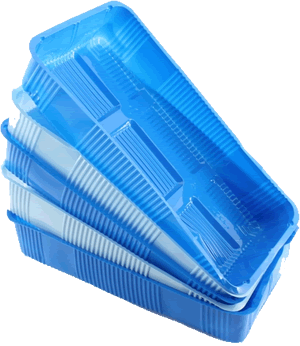 |
PET - Polyethylene terephthalate |
PET (polyethylene terephtalate) was developed by the two chemists John Rex Whinfield and James Tennant Dickson from the British company Calico Printer´s Association in Manchester in the year 1941 and was patented by them and their employer. It was then used for synthetic fibers like Polyester, Dacron® and Ethylene®. The latter two are brand names, whereas polyester or polyethylene terephthalate are generic product names. Nathaniel Wyeth patented the PET-bottle in 1973.
PET belongs to the family of polyesters and is a strong, clear and lightweight plastic. When used for fibers and fabrics it usually is called “polyester”, while for the usage of bottles, containers and packaging it is named “PET”, or sometimes “PETE” or “PET resin”, formerly it was called PETP or PET-P. The term “polyethylene terephthalate” is sometimes confusing, as PET does not contain polyethylene. PET is a linear thermoplastic resin and is created through condensation of therephthalate acid and ethylene glycol.
PET production is an important part of polymer production all over the world, but it should not be confused with polyethylene (PE) and polypropylene (PP), their worldwide production is a much bigger one. |
|
|
PET Properties
Depending on its thickness, PET may be semi-rigid to rigid and it is lightweight. It provides a good barrier against gas, alcohol (additional treatment required) and solvents, its barrier against humidity is fair. It is naturally colorless with high transparency, impact-resistant and strong. The most important characteristic of PET is related to as “intrinsic viscosity”. The intrinsic viscosity of the material is measured in deciliters per gram and depends on the length of its polymer chains. The longer the polymer chains, the more entanglements between chains exist, and thus the higher is the viscosity. The average chain length of a certain batch of resin may be controlled during polycondensation.
PET is a very inactive material, which is resistant against micro-organisms and shows no reaction with food products; therefore it is preferred for packing of food, drinks and pharmaceuticals. PET has been approved as safe for food and beverages by health-safety agencies throughout the world. PET is recyclable, sustainable and it is the most recycled material in the world. It may be recycled, ever and anon, back into containers for food and beverages or into clothing, automotive parts and numerous other products.
|
PET Applications
PET is the material of choice for food and beverages; it is lightweight, shatter resistant, strong, hygienic and preserves freshness. Most commonly it is used for the packing of carbonated soft drinks and water, but also for thermoforming applications and engineering resins, often used in combination with glass fiber.
Biaxial oriented PET film (one of its trade names is “Mylar”) may be aluminized through the evaporation of a thin metal film onto it. This reduces its diffusivity as it becomes reflective and opaque (MPET). With these properties it is utilized for various applications, for instance thermal insulation. Due to its mechanical strength, PET is frequently used in tape applications, for example the carrier for magnetic tapes or the bearing of adhesive tapes.
Non-oriented PET sheet is used for thermoforming packing trays and blisters. These trays may be used for frozen meals and if crystallizable PET is used, they withstand freezing as well as higher oven temperatures.
|
Other commonly used thermoplastics
|
 |
|